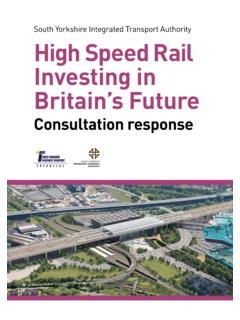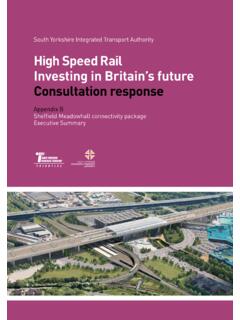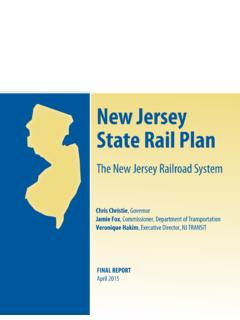Transcription of High-speed train operation in winter climate - gronataget.se
1 High-speed train operation in winter climate by Lennart Kloow Stockholm 2011 KTH Railway Group and Transrail KTH Railway Group Publication 1106 Transrail Publication BVF5 R2 ISBN 978-91-7501-121-9 Postal address Royal Institute of Technology (KTH) KTH Railway Group SE-100 44 Stockholm, Sweden Transrail Sweden AB L fstr ms All 6A SE-172 66 Sundbyberg, Sweden Telephone +46 8 790 7603 +46 8 790 7628 +46 8 404 0993 E-mail High-speed train operation in winter climate ii High-speed train operation in winter climate iii High-speed train operation in winter climate iv High-speed train operation in winter climate v PREFACE AND ACKNOWLEDGEMENTS This is a study of the winter challenges regarding High-speed passenger train services in the European Nordic region.
2 The investigation has been performed within the Swedish Transport Administration s (Trafikverket) research project Gr na T get (Eng: Green train ). In 2006 a winter report High-speed train operation in winter climate was presented as a part of the research and development programme Gr na T get . That study was concentrated to the Nordic countries regarding the interviews. In addition a literature research brought up some High-speed winter solutions from other countries, mainly Japan. As the gathered information was mainly from Norway, Sweden and Finland, a second study was proposed with the aim to include knowledge of very high speed operation which nowadays is common in train operation in many central and southern European countries. The new study was to include train operation far above 200 km/h.
3 The winter 2009 2010 was harsh, also in many central European countries and resulted in a number of winter -related operational problems. Governments in some countries and organisations, such as the UIC, have thereafter started investigations to find out what to do to reduce the problems in the future. Many of the experiences in this report are from the winter 2009 2010. Some examples from Sweden are also given from the winter 2010 2011 that started in the same way with a long period of cold weather and a lot of snow as the year before. The big difference from previous winter was that snowfall and coldness, resulting in operational problems, started around a month earlier, mid November in the Stockholm area. The railway networks are in very many aspects combined regarding High-speed operation and operation of normal passenger and freight trains in lower speeds.
4 That is why the High-speed trains most often are affected by the normal operation and vice versa. Some of the related experiences in this report primarily come from slower trains or even shunting movements. The reason is that they are a part of the railway system and in this case affects the entire railway operation . The outcome of this investigation has been much dependent on the interviewed persons and their shared experiences. The persons included have different backgrounds but act in the railway sector. All interview persons have been very helpful and made contributions from different perspectives that have been of great value for the work. I would like to thank all interviewed persons who through their participation have made this study possible. Also a special thank to the Swedish Transport Administration for financially supporting this study.
5 The previous report from 2006 has been the base for this extended report. I want to thank the co-writer of that report, Mattias Jenstav, for his good cooperation and contribution. Finally I thank Professor Evert Andersson at the Royal Institute of Technology (KTH) for his comments and helpfulness during the work to finalize this report. Nevertheless, any errors in this report are my own. If nothing else is stated, the photos are copied from the author s collection. Sundbyberg, September 2011 Lennart Kloow High-speed train operation in winter climate vi High-speed train operation in winter climate vii ABSTRACT This study is a part of Gr na T get (Eng: Green train ) research and development programme that is preparing for new High-speed trains in Sweden.
6 The purpose of this study is to: Strengthen the ability to design the next generation High-speed passenger trains and infrastructure in Sweden. Influence the all-European standardisation of rolling stock and infrastructure. During winters the train services in European Nordic countries in one way or another and to various extents are struck by constantly recurring problems related to snow, ice and coldness. If a winter is harsh and the circumstances are unfavourable the problems that arise can result in severe consequences for train operations and economy. That is why there has been a need for a project that gathers existing winter experiences and knowledge from a Nordic perspective, something a first investigation tried to fill and this extended edition adds further aspects to.
7 The main purpose of this investigation is to compile the knowledge and experiences regarding the High-speed passenger services in winter climate the affects of snow, ice and coldness concerning both infrastructure and rolling stock. In order to fulfil this aim both a literature study and qualitative research interviews have been carried out with representatives of the European railway sector. From a Scandinavian point of view studies of this kind are of importance as most suppliers of rolling stock and railway equipment are concentrated to countries where the climatic conditions are different from the Nordic. In Scandinavia the train services are expected to be unaffected during a fairly long winter time, except in the most severe situations. This results in higher requirements as regards design, operation and maintenance.
8 This investigation looks into these demands from both a rolling stock and an infrastructure perspective for the Scandinavian High-speed services. In the study all reported problems, as well as proposed measures against the problems, have been listed. The report forms a summary and checklist of winter problems, more or less irrespective of speed . Based on the list, the problems judged to increase at higher speeds have been pointed out in specific. From this investigation the overall conclusion is that winter is unfortunately not an issue of high priority the year around. This conclusion can amongst others be drawn from the too often acute and short-term solutions and measures applied when the problems arise. The reason for this is often a short memory . After a number of mild winters with very few winter related problems, the responsible persons within the railway sector tends to forget which necessary preparations that have to be made and how to reduce the negative impact of a long and cold winter on the railway operation .
9 The study identifies that: There are still unsolved winter problems such as difficulties with switches, brakes, running dynamics etc. There is a lack of experiences and knowledge of High-speed operation (far above 200 km/h) in winter climate . The operational problems often increase with the duration of the winter period, the length of a period with temperatures below 0 C, and the persistence to manage the rail operation is low. Many problems are more or less independent of the train speeds; others are expected to increase when the speeds of the trains are increased. This study has shown that the High-speed winter problems (200 km/h and above) and the very high speed winter problems (250 km/h and above) are very similar although the following differences have been found: 1.
10 The current collection, the system pantograph catenary, is speed -dependent. Coldness or ice on the contact wire or on the pantograph s arm or head degenerate the behaviour of the system more with increasing speed . 2. Every speed reduction or unplanned stop for a High-speed train gives a greater relative time loss than would be the case for a slower train . This indicates that trains for very high speed High-speed train operation in winter climate viii shall run on separate lines all year round to reduce the risk of them being stopped or delayed by freight trains or shunting movements. 3. Brake troubles and reduced braking effort will give significantly longer braking distances at very high speed . 4. High-speed tracks normally consist of improved infrastructure with a well drained ground and therefore the problems with frost in the ground are rather rare.





